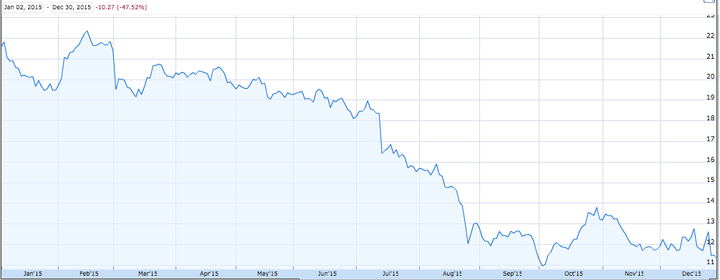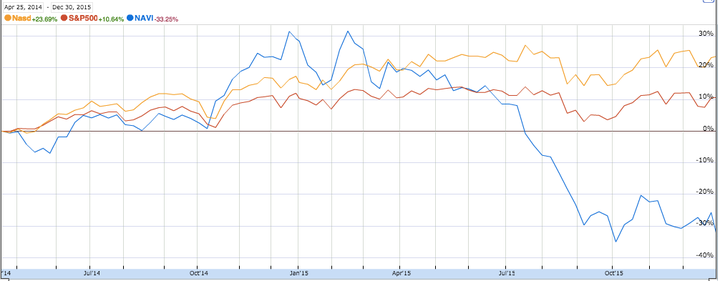
Two years ago, Sen. Elizabeth Warren demanded to know why a government-sponsored bank meant to expand homeownership was instead lending money on the cheap to student loan company Sallie Mae, boosting its profits at the public's expense.
Last week, the Massachusetts Democrat achieved a quiet victory after the Federal Home Loan Bank of Des Moines restricted Sallie Mae offshoot and student loan giant Navient Corp.'s access to ultra-cheap funds -- causing stock in the company to plummet and demonstrating the unique ability of one of the Senate’s most liberal lawmakers to influence the bottom line of one of the nation’s largest publicly traded companies.
Navient shares have fallen more than 10 percent this week, after the company disclosed the Des Moines bank's Dec. 22 move to investors on Monday morning. The stock has plunged 48 percent this year.

The value of Navient stock has nearly halved this year, falling from $21.61 per share at the end of trading in 2014 to $11.33 per share at Wednesday's close.
"Navient has always had privileged access to cheap capital,” said Barmak Nassirian, a higher education expert and longtime critic of the company. “And they’ve always justified this in very highfalutin language -- ‘What’s good for them is good for the country’ -- but they’ve never passed on any of the comparative savings that they’ve enjoyed to the intended beneficiaries: students. The criticism [Warren] has directed at the company has proven to be right at every turn.”
Patricia Christel, a Navient spokeswoman, didn't respond to a request for comment. The company said in a securities filing it believed the Federal Home Loan Bank of Des Moines reduced its credit line after changing the formula it uses to set borrowing limits.
Angela Richards, a spokeswoman for the Des Moines lender, declined to comment on the bank's relationship with Navient. Richards said the home loan bank regularly changes its formula after reviewing its borrowers and wider industry and economic trends.
It wasn’t until 2013 that Navient’s reliance on the Federal Home Loan Bank of Des Moines for cut-rate cash drew public attention.
Sallie Mae, Navient’s parent company until its spinoff in 2014, enjoyed the use of taxpayer-backed funds "at favorable terms," despite the fact that it "does not originate a noteworthy level of mortgages" -- a point that its regulator, the Consumer Financial Protection Bureau, said was "worth noting" in a May 2013 report on the affordability of student loans.
A month later, Warren launched a public campaign condemning Sallie Mae for taking advantage of taxpayer-subsidized funds to reduce its costs without passing along those savings to student loan borrowers.
Federal Home Loan Banks, created by Congress in 1932 during the Great Depression, aim to make homeownership more affordable by lending cheaply to financial companies that in turn pledge home mortgages as collateral.
But since 1999, the Des Moines branch has been lending against government-insured student loans made under the bank-based Federal Family Education Loan program, despite its lack of connection to home loans.
Student lenders loved the FFEL program because they could generate easy profits: Loan owners reaped the rewards of borrowers’ payments but didn’t have to shoulder the full cost of loan defaults, a burden that fell to taxpayers under an arrangement created by the federal government.
And while the Des Moines bank’s loans were designed to be limited to financial firms that made home loans -- not to student lenders -- Sallie Mae obtained membership in the bank's network through a subsidiary.
Congressional Democrats and the Obama administration ultimately killed the FFEL program in 2010, mandating that all new federal student loans originating after June of that year would be made directly by the Department of Education. As a result, the amount of outstanding FFEL loans has fallen 30 percent over the past five years to $363.6 billion, federal data show.
But Sallie Mae, and later, Navient, maintained membership in the Des Moines bank’s network and kept tapping the bank for low-cost, taxpayer-subsidized loans even though there were no new federal loans it could make.
Warren: Taxpayers subsidized Sallie Mae's profits at the expense of U.S. homeownership
In June 2013, Warren sent letters to Jack Remondi, Sallie Mae's chief executive (and now Navient’s top executive), and Edward DeMarco, who regulated the Des Moines lender as the then-acting director of the Federal Housing Finance Agency, demanding to know why Sallie Mae was able to benefit from government-subsidized financing.
At the time, Warren said she was “surprised” to learn that taxpayer-backed money meant to boost homeownership had instead been subsidizing Sallie Mae, the nation’s largest private student lender.
The arrangement was highly beneficial to Sallie Mae, which could borrow money at bargain prices even after it was no longer able to originate new government-insured loans after June 2010.
For example, in the first six months of 2013, Sallie Mae enjoyed a 0.28 percent interest rate when borrowing from the Des Moines bank, making it the student lender’s lowest-cost source of funds outside of debt tied to derivatives. From 2010 to 2012, the Des Moines bank lent Sallie Mae money at rates that on average were no higher than 0.35 percent.
In effect, Sallie Mae and Navient have been able to borrow billions of dollars at what Warren said were “astonishingly low rates” from a taxpayer-backed lender for next to nothing, purely to fuel the student loan giant’s growth.
As it borrowed, Sallie Mae was also making loans to students at interest rates up to 40 times the rate the company paid to borrow from the Federal Home Loan Bank of Des Moines.
To Warren, the fact that taxpayers were subsidizing Sallie Mae and Navient’s profits was bad enough. But there also was an urgent public policy concern arising from the company’s relationship with the Des Moines bank: The government-backed lender and its regulator risked undermining their homeownership mission “by helping finance more student loan debt.”
In April 2013, researchers at the Federal Reserve Bank of New York published an explosive report: For the first time in at least a decade, data showed that young Americans with student debt were less likely than their unburdened peers to have home mortgages.
Sallie Mae and Navient’s arrangement with the Federal Home Loan Bank system not only amounted to a “backdoor way to subsidize highly profitable private student lenders,” as Warren put it, but it also may have had the perverse effect of actually limiting homeownership.
“Every dollar that is used for another purpose is a dollar that is not available to finance the purchase of homes,” Warren told Richard Swanson, the head of the Federal Home Loan Bank of Des Moines, during a November 2013 Senate banking committee hearing.
During a testy exchange, Swanson defended his bank’s relationship with Navient’s predecessor company, Sallie Mae. The company was a member of the bank’s network, he said, and it was free to borrow from the Des Moines lender as long as it pledged eligible collateral.
That year, Sallie Mae stopped disclosing details of its Des Moines credit line, following criticism from Warren and intense news coverage. Navient has continued the practice of keeping investors in the dark about how much it borrows from the Des Moines bank and its rate of interest.
Navient's stock takes a nosedive
Now, some two years later, Navient faces the prospect of higher borrowing costs and less easy money in part because of Warren.
The move by the Federal Home Loan Bank of Des Moines to immediately halve the company’s credit line has fanned some investors' long-held worries that the thinly capitalized company may not be able to pay back its existing creditors without issuing more debt or reducing share buybacks and dividends -- all moves that could cause the company's stock price to fall even further.
Navient’s executives and allies are trying to calm fears that the company’s reduced credit line could further its stock slide. Some analysts and investors think that because the line of credit was meant to finance the acquisition of old student loans from the FFEL program -- a once-easy source of profit that’s now harder to amass because Navient has less money readily available -- it'll be more difficult for the company to increase its earnings now that it no longer has access to an abundance of cheap financing.
It also compounds existing concerns about Navient’s ability to generate sufficient profits as the company contends with a new era of federal oversight designed to clean up what the Consumer Financial Protection Bureau has referred to as “widespread failures” afflicting the student loan market.
Navient's cost to borrow -- a measure of financial markets’ confidence in the company’s ability to pay its bills -- for short periods of time has more than tripled since last year, according to the company’s latest quarterly report to investors.
Through the first nine months of 2014, it cost Navient about twice as much to borrow for long periods of time versus for short-term loans. During the same period this year, the company paid more for short-term debt than it cost to borrow long-term.
Navient’s lenders are charging the company more as Navient has become more reliant on borrowed money to fund itself. Its level of equity relative to its total assets stood at 3.2 percent on average during the first nine months of 2014. That measure has fallen to 2.8 percent this year, according to the company's latest quarterly report.
Net income is down 20 percent from last year. Navient said it generated $885 million in net income during the first nine months of last year. During the same period in 2015, Navient said it recorded $711 million in net income.
On Dec. 21, credit rater Standard & Poor's downgraded Navient’s senior unsecured debt further into junk territory, giving it a rating of BB-, three levels below investment-grade.
S&P also announced that it may lower the company’s rating again in the next six to 12 months if its confidence in Navient’s ability to meet its obligations further erodes. The student loan giant has significantly more unsecured debt than it has assets it can easily borrow against, a source of worry that’s likely to persist for the next several years, the credit rating firm said.
Traders are increasingly betting that Navient may default on its obligations. The cost of insuring against a Navient default has more than doubled, soaring 151 percent through Tuesday since the start of the year, according to data from Markit Group Limited.
Traders have amassed $9.9 billion of default-insurance contracts on Navient debt as of Dec. 25, according to Depository Trust & Clearing Corp. data.
Goldman Sachs analysts who follow Navient for clients estimate that Navient has about $4.7 billion of student loans it can borrow against, according to a Dec. 9 note. Navient executives believe markets’ concerns about the company’s available cash and funding costs are “overdone,” the Goldman analysts said.
But the Federal Home Loan Bank of Des Moines’s decision to immediately cut Navient’s credit line revived worries that the company has little breathing room.
The Des Moines lender reduced Navient’s line of credit from $10.7 billion to $5 billion, with a further drop to $3.9 billion beginning next November. That means the company would be able to borrow only an additional $2.5 billion under its existing credit lines, down from $9.3 billion before the change. Navient has already drawn down 87 percent of its existing lines of credit, according to a Monday securities filing.
Traders pounced on the news.
The 9.1 percent drop in Navient’s share price Monday was the largest one-day fall in Navient stock since July 14, when it tumbled 10.6 percent, and the second-largest of the year.
The company’s stock is down more than 33 percent since it started trading after Navient’s April 2014 spinoff from Sallie Mae.
By contrast, the Nasdaq Composite -- an index of stocks that, like Navient, trade on the Nasdaq stock market -- is up about 24 percent during the same period, while the Standard & Poor’s 500 Index -- of which Navient is a part -- has climbed nearly 11 percent.

Navient Corp. shares appear in blue in the chart above. Nasdaq Composite is in yellow, and the S&P 500 is in red. Shares in Navient have fallen more than 33 percent since it spun off from Sallie Mae in 2014. Investors who bought the stock in April that year could've experienced double-digit gains had they purchased baskets of stock tracking the S&P 500 or Nasdaq Composite indices.
Some analysts who follow Navient think the company’s stock is worth more than what the market values it at, in part because the company can acquire more outstanding loans from the since-discontinued FFEL program, assets that would likely boost its earnings.
That’s partly why the loss of so much borrowing capacity from the Federal Home Loan Bank in Des Moines hurt Navient stock: Navient used the easy money to finance its purchase of old FFEL loans from other financial companies.
Sameer Gokhale, an analyst who follows Navient for the financial services firm Janney Montgomery Scott, said in a note this week that he cut his projection of what Navient stock is worth simply because he’s no longer sure whether Navient can buy more FFEL loans.
At the end of trading on Wednesday, Navient stock was less than 7 percent above its all-time low.
Navient's fortunes fall as borrowers sink deeper into debt
The company's fortunes this year have been buffeted by a series of events related to its treatment of student loan borrowers.
Navient, a major Education Department contractor, faces a rash of investigations from state and federal authorities over whether it mistreated debtors with private or federal student loans.
In February, the Education Department announced it would stop sending new accounts to Navient under its contract to collect on defaulted federal student loans. That contract has since expired.
The Consumer Financial Protection Bureau, which has been investigating Navient for nearly two years, told the company in August that the agency’s senior officials were weighing whether to sue the company in court after its enforcement staff had found enough evidence to indicate Navient had violated consumer protection laws.
This month, President Barack Obama signed into law a provision that probably will reduce the amount of new loans Navient receives every year from the Education Department under a separate loan servicing contract.
Government scrutiny has risen alongside fears about the nation’s growing stack of unpaid student loan bills and the risk to general U.S. economic growth as overly indebted Americans cut back on spending, borrowing or investments as a result of their student debt.
Total student debt has roughly doubled since 2008 to $1.3 trillion, while the average load for federal loan borrowers has risen 51 percent, federal data show. Americans are more likely to be at least three months late on their student loan payments than any other form of household debt, according to the Federal Reserve Bank of New York.
“Navient is a creature of public policy, not the natural evolution of capital in the market,” said Nassirian, the higher education expert who now works on federal policy issues for the American Association of State Colleges and Universities.
“It’s a Frankenstein that the U.S. Congress created and funded and gave all kinds of advantages. This is the result of corporate welfare.”
Also on HuffPost:

